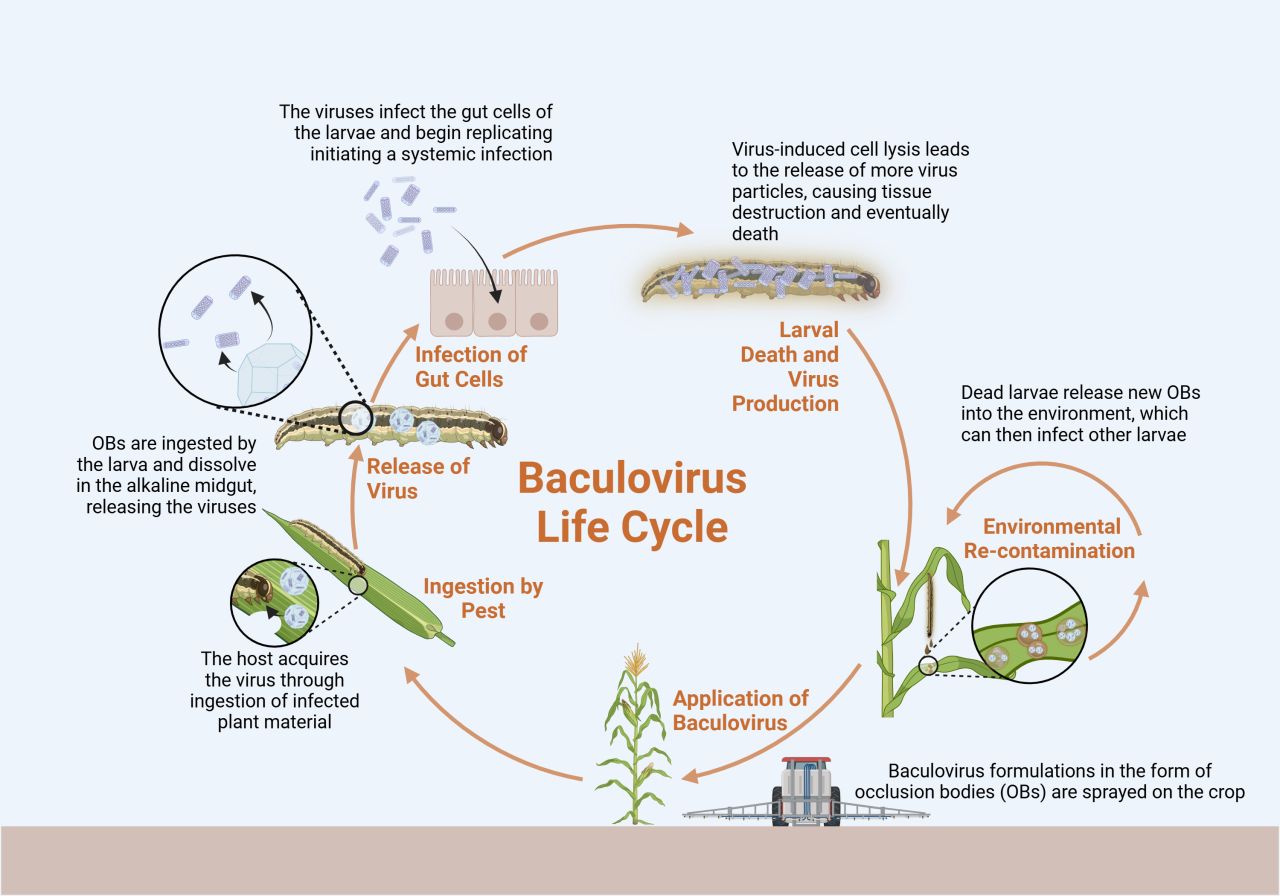Baculoviruses: a natural and sustainable solution for pest control
Baculoviruses specifically attack certain insect species and could become an environmentally friendly alternative to chemical insecticides.

The fall armyworm (Spodoptera frugiperda) is a highly invasive pest that feeds on crops like maize, rice, and cotton, causing substantial agricultural losses. Image: Adobe Stock
Agricultural pests cause significant crop losses worldwide, threatening food security and increasing reliance on chemical pesticides. While chemical insecticides have been effective, they come with serious concerns, including resistance development, environmental contamination, and harm to beneficial insects.
One promising alternative is the use of baculoviruses, naturally occurring viruses that specifically target insect pests. These viruses have been studied for decades and are now recognized as a powerful tool in integrated pest management (IPM). Unlike most chemical insecticides, baculoviruses are highly specific to their target pests, making them an environmentally safe and sustainable alternative for modern agriculture.

A) Healthy Spodopera frugiperda larva C) Infected larva killed by the virus. Image: Adapted from Gómez-Valderrama et al. 2022
History of baculoviruses in pest control
The history of baculoviruses in pest control dates back to the early 20th century when scientists first observed virus-infected insect larvae in nature. By the 1940s, researchers began exploring their potential as biological insecticides, and by the 1970s, the first commercial baculovirus-based biopesticides were developed. These early products targeted pests like the cotton bollworm. Since then, extensive research has led to highly effective viral biopesticides that are now used worldwide to protect crops against various pest species.
One virus, two forms
Baculoviruses have two forms during their life cycle:
1. Occlusion bodies (OBs) are protective protein particles that contain the virus, allowing it to survive outside the host in the environment. This form is crucial for spreading the virus between insects.
2. Budded viruses are virus particles that help the infection spread within the insect’s body. They are formed when the virus exits an infected cell by "budding" through the cell membrane. They are specialized for internal infection, from one cell to another inside the host.

Scanning electron microscopy (SEM, left) and transmission electron microscopy (TEM, right) images of baculovirus occlusion bodies (OBs) isolated from an infected larva. Scale bars = 0.5 μm. Images: Adapted from Lei C et al. 2020.
Mode of action
Baculoviruses operate through a precise mode of action when encountering insect hosts. The infection process begins when an insect ingests OBs containing viruses. These OBs dissolve in the alkaline environment of the insect's midgut, releasing the viruses, which then infect the midgut epithelial cells. From there, the virus spreads systemically throughout the insect's body in the form of budded viruses, resulting to the death of the infected larva. As the cadaver liquefies new OBs are released in the environment continuing the infection cycle and providing sustained pest control.

The diagram shows the baculovirus life cycle in lepidopteran pests. Sprayed occlusion bodies (OBs) are ingested by larvae, releasing the infectious virus particles that infect the midgut and spread through the body. This leads to larval death, releasing new OBs into the environment, continuing the infection cycle for pest control. Image: © Jérémy Gonthier, Created with Biorender.
In vivo production process
The production of baculovirus insecticides is primarily carried out in vivo using insect larvae. Mass-produced host larvae are infected with the baculovirus by contaminating their food. As the infection progresses, the virus replicates within the host, eventually leading to the insect's death and liquefaction, releasing large numbers of OBs.
In vivo baculovirus production is a proven and effective method, ensuring high-quality virus yield, but it comes with cost challenges. Expenses arise from insect rearing, processing, as well as infrastructure requirements. Each larva produces a limited amount of virus, necessitating large-scale rearing. However, the method benefits from natural host-virus interactions, preserving viral potency, and ongoing advancements in automation and rearing techniques are helping to improve efficiency and scalability.
Baculoviruses in agriculture
Baculoviruses are being successfully used to control many major agricultural pests, including for example:
- Codling moth (Cydia pomonella): A serious pest of apple and pear orchards. Widely used in organic and integrated pome fruit production.
- Cotton bollworm (Helicoverpa armigera): One of the most damaging pests affecting among others corn, cotton, tomatoes, and different legumes.
- Spodoptera species: Some species of this genus are major threats to key crops worldwide.
Many new baculovirus products are under development but their registration and integration into IPM programs are taking time.
To view this content, you must accept marketing and third-party cookies.
Advantages and challenges
Baculoviruses provide a highly specific and environmentally safe alternative to chemical insecticides. Unlike broad-spectrum chemical insecticides, baculoviruses target specific insect species, minimizing the impact on beneficial insects such as pollinators and predators. This specificity arises from the intricate interactions between viral proteins and host cell receptors, ensuring that only target pests are affected. Furthermore, baculoviruses degrade naturally, avoiding soil and water contamination. Their use in resistance management is particularly valuable. When combined with other control methods in IPM, baculoviruses offer a long-term, sustainable pest control solution and can reduce resistance build-up.
However, they have limitations. Baculoviruses act more slowly than chemical insecticides, taking several days to kill pests, which may be a drawback in severe outbreaks. They are also sensitive to UV light, reducing their effectiveness.
Finally, baculoviruses face a lengthy regulatory approval process due to extensive safety and environmental assessments. The costly and complex registration process slows adoption and investment, while varying regulations across regions create additional hurdles. Streamlining and simplifying approval processes could boost accessibility and innovation in baculovirus-based pest control.
Future of baculovirus-based pest control
With rising pesticide resistance and environmental concerns, baculoviruses offer a natural and sustainable pest control alternative. Researchers are improving virus efficacy, field stability, and large-scale production, while combining baculoviruses with other biocontrol agents to enhance their impact in IPM.
Despite their potential, baculoviruses remain underutilized. Of over 600 identified strains, only 60 have been commercialized, mostly for high-value crops. Expanding their use to new pest species could transform pest control, especially as chemical resistance and regulatory shifts drive demand for alternatives. With continued innovation, baculoviruses are set to play a key role in future agriculture.
References
Gómez-Valderrama J et al. 2022. Fungal and viral entomopathogens as a combined strategy for the biological control of fall armyworm larvae in maize. CABI Agric Biosci 3;24. https://doi.org/10.1186/s43170-022-00094-7
Lei C et al. 2020. Molecular and Biological Characterization of Spodoptera frugiperda Multiple Nucleopolyhedrovirus Field Isolate and Genotypes from China. Insects 11;777. https://doi.org/10.3390/insects11110777
Lacey LA (Ed.) 2016. Microbial control of insect and mite pests: from theory to practice. Academic Press.
Gonthier Jet al. 2023. Few indirect effects of baculovirus on parasitoids demonstrate high compatibility of biocontrol methods against Tuta absoluta. Pest Management Science, 79;4:1431-1441. DOI: 10.1002/ps.7314
